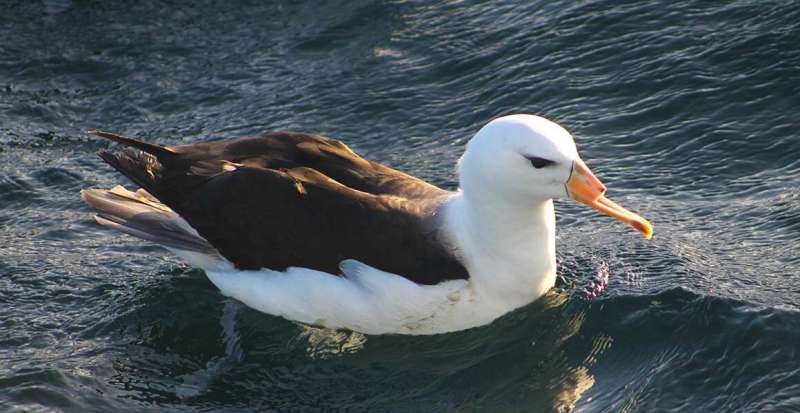Fisherman have been cutting the bills off seabirds such as albatrosses that get caught on their longline fishing equipment, tossing them back into the ocean alive. How long the birds survive for is not known. Credit: Nicholas Daudt
Albatrosses and petrels are the most threatened group of birds in the world. A new study has now revealed the impact that fisheries and in particular longline fishing is having upon these endangered birds.
It has long been known that the fishing industry poses a threat to marine life with mammals, sea turtles and seabirds all having been documented as victims of bycatch. A new study from an international team of researchers, including Dr. Alex Bond, Senior Curator in Charge of Birds at the Natural History Museum, has now documented some of the horrific injuries that albatrosses and petrels are enduring at the hands of the industry.
The team first observed fishermen off southern Brazil who were trying to prevent birds stealing bait in pole-and-line and handlining fisheries. The tactics employed by fishermen included hitting birds with a metal piece attached to a pole-and-line. Other birds were trapped on lines and killed, or caught alive and then either killed or mutilated through aggressive handling by the fishermen as they were removed from the lines.
To capture this data the team put out a worldwide call for anyone who had records of the kind of mutilation they were trying to document. When they collated observations received dated from 1999–2019 it became obvious that the practice of cutting birds free from lines by slicing through the bill is highly localized.
The data showed records of birds with these types of injuries occurring across the coastal waters of Brazil, Uruguay and Argentina. These records included 16 birds from four species, two of which are globally threatened, being intentionally killed or mutilated. The records indicated that birds had suffered head trauma, broken limbs, wounds or bill mutilation. In addition to these a further 29 birds, from eight species, were recorded alive with serious bill mutations, most likely the result of fishermen intentionally cutting the birds bills.
Dr. Alex Bond explains, "It appears to be a very specific thing that fishermen in this region are doing," explains Alex. "It's clear that some operators are literally just taking a blade and cutting the bill off to more expeditiously unhook the bird, and then tossing the bird overboard. There is no way to know just how many of these threatened birds are being killed as a direct result of injuries obtained from fishermen. The cases we document here most likely represent a small percentage of a much larger picture."
The observations of deliberate killing of seabirds on multiple vessels and the sightings of live mutilated birds suggests these practices are a common occurrence that has remained largely undocumented.
Dr. Alex Bond continues, "The brutal practices we document such as observations of fishermen cutting large percentages of bills from birds before throwing them overboard would most likely cease in the presence of on-board observers. The lack of information is a real problem and means we cannot currently justify or guide policies that might limit these practices."
It is hoped that this paper will be the first step in preventing the cruel practices it documents. The team suggest harmless deterrents, like water curtains, jets or sprayers that could prevent birds diving for bait lines and subsequent injury or capture, combined with existing mitigation measures, such as setting hooks at night, weighted hooks, and streamers to deter birds from diving after baited hooks. Further to preventative measures, investment in education is also recommended in the form of awareness and training campaigns for fishermen. This could limit aggressive handling practices of birds caught alive and ensure safe release.
For more immediate action the team also suggest an increased use of remote electronic monitoring (REM). This involves the use of GPS and video cameras to monitor fishing activities on a vessel at sea. The systems have been shown to reduce harmful or illegal activity directed at marine wildlife.
Now that this brutal practice has been identified, it is hoped that action can now be targeted to the fisheries which are conducting it.
The study Intentional killing and extensive aggressive handling of albatrosses and petrels at sea in the southwestern Atlantic Ocean will be published in the journal Biological Conservation in December 2020.
More information: Dimas Gianuca et al. Intentional killing and extensive aggressive handling of albatrosses and petrels at sea in the southwestern Atlantic Ocean, Biological Conservation (2020). DOI: 10.1016/j.biocon.2020.108817
Journal information: Biological Conservation
Provided by Natural History Museum






















